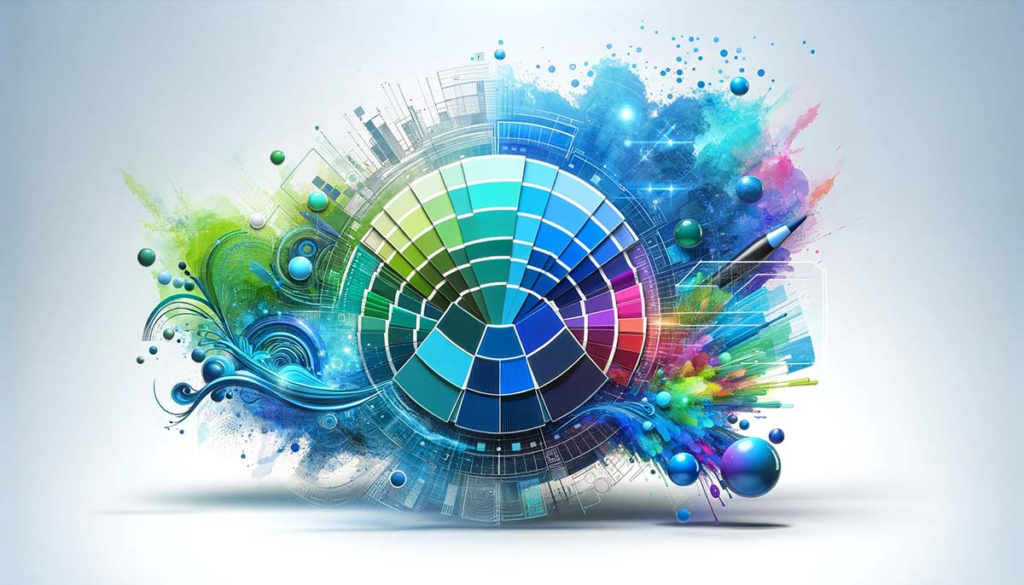Cyanová is a special blue-green pigment that has gained popularity across various fields such as art, fashion, digital design, and even personal wellness. Its unique appearance—a blend of calming blue and refreshing green—creates a color that symbolizes both tranquility and energy. The word “cyanová” comes from the Greek word “kyanos,” meaning dark blue, reflecting its rich and deep hue.
As society moves toward cleaner, more natural aesthetics, cyanová perfectly fits modern tastes. From interior design in American homes to digital interfaces on popular apps, cyanová is showing up more and more. It is not only loved for its beauty but also for the feelings it inspires—peace, balance, and modernity. This article will explore cyanová in-depth, offering insights, uses, cultural meanings, and more in a very simple and easy-to-read format.
What Is Cyanová?
Cyanová is a pigment that produces a striking blue-green color. A pigment is a substance that gives color to materials, whether it’s paint, fabric, or digital screens. Cyanová is made by blending:
- Cyan blue: a light, fresh blue that reminds people of the sky or clean water.
- Green: especially viridian or sea-green tones that bring to mind forests and plants.
The result is a balanced color that feels cool, clear, and harmonious. Cyanová is neither too dark nor too bright, making it very versatile. It’s widely used in different products because it easily combines with other colors and creates a clean, modern feel.

People are drawn to cyanová because it has a natural look but also appears high-tech. That balance makes it useful in many areas, from fashion to websites. It feels like nature and technology combined in one color.
History and Origin of Cyanová
Although the name cyanová is relatively new, the blue-green color combination has been around for centuries. Ancient Egyptians used blue-green minerals such as malachite and turquoise in jewelry and wall paintings. In Greek and Roman times, artists crushed natural stones to create blue-green pigments.
The name “cyanová” likely evolved from the Greek “kyanos” for dark blue. Over time, cyan colors became essential in painting, especially during the Renaissance and in 19th-century Impressionist art. Artists like Monet and Van Gogh used shades similar to cyanová to represent water, sky, and emotional moods.
In the 20th and 21st centuries, cyan tones were embraced in printing, design, and digital media. Cyan became one of the four base colors in modern printing (CMYK: cyan, magenta, yellow, and black). The specific blend of cyan and green—cyanová—became popular as people looked for fresher and more vibrant alternatives to plain blue or green.
Also Read: www.goodmooddotcom.com cruising category: Discover the Best Cruise Deals
Where Can You Find Cyanová Today?
1. Art and Painting
Artists love cyanová because it gives emotional depth and vibrant contrast. It works well for painting seascapes, skies, abstract pieces, and calming environments. Watercolor artists often use cyanová to create soft gradients, while digital artists use it to create sleek, futuristic effects.
Professional painters use cyanová in oil and acrylic formats. Its ability to stand out without being too loud makes it a great background or highlight color.
2. Fashion
Cyanová is a trending color in the fashion industry. Designers use it for both casual and formal wear. It’s commonly seen in:
- Spring and summer collections
- Resort and vacation wear
- Accessories like scarves, handbags, and jewelry
The color appeals to all genders and age groups because it’s soft but energetic. Cyanová works well with neutral tones like beige, gray, or white, and it can also be paired with warmer tones like coral or peach.
Fashion brands use cyanová not only for its beauty but also because it gives a sustainable, eco-friendly vibe. Many clothing companies promoting nature-inspired fashion use this color in their campaigns.
3. Interior Design
Cyanová is a perfect choice for interior design. It creates a soothing and clean environment. Here are some popular uses:
- Accent walls in living rooms or bedrooms
- Kitchen backsplashes and cabinets
- Bathroom tiles and accessories
- Furniture like sofas and chairs
Homeowners in the U.S. are increasingly choosing cyanová for its calming effect. It gives a sense of space and airiness, especially in smaller rooms or apartments.
4. Technology and Digital Media
In digital design, cyanová is a favorite among app developers and web designers. It appears in:
- Website backgrounds
- Icons and buttons
- App logos
- Dashboard themes
Because it’s easy on the eyes and looks clean on screens, cyanová improves the user experience. Many tech brands use cyanová in their logos to communicate innovation, clarity, and freshness.
5. Cosmetics and Personal Style
Cyanová is also making its way into beauty products:
- Nail polish
- Eye shadow
- Hair dye
- Lip gloss
For personal style, cyanová adds boldness without being too flashy. It’s often used in summer beauty trends and festival looks.
Why Is Cyanová So Popular?
1. Modern Look
Cyanová fits well in today’s design trends. Its clean, crisp look makes it a favorite for minimalistic and high-tech designs. Whether it’s a modern kitchen or a futuristic website, cyanová works well.
2. Nature Connection
It reminds people of natural elements like oceans, forests, and the sky. This makes it perfect for eco-conscious brands and consumers who love nature.
3. Gender-Neutral Appeal
Unlike pink or dark blue, cyanová is more neutral. It appeals to a wide audience, including those who prefer gender-neutral colors. That makes it a smart choice for unisex clothing and products.
4. Soothing Feeling
Cyanová can calm your mind and reduce stress. That’s why it is used in spas, yoga studios, and wellness centers. The color sends signals of peace, safety, and balance to the brain.
Psychological Meaning of Cyanová
Colors can affect mood and emotions. Cyanová holds strong psychological significance:
- Calmness: Helps reduce anxiety, often used in therapy rooms and meditation spaces.
- Balance: The even mix of blue and green creates harmony.
- Creativity: Boosts focus and original thinking.
- Fresh Start: Associated with clarity and new beginnings, useful in branding and advertising.
Cyanová is especially useful in spaces where calm and concentration are needed—offices, classrooms, and clinics.
How to Use Cyanová in Daily Life
1. In Your Home
Use cyanová for walls, bedding, or curtains to create a relaxing environment. It works especially well in:
- Bedrooms: for better sleep
- Bathrooms: for a spa-like feel
- Kitchens: adds freshness and energy
2. In Your Wardrobe
Add a cyanová scarf, tie, or shoes to brighten up your outfit. It pairs well with jeans, beige pants, and even formal wear.
3. In Art Projects
If you’re into painting, sketching, or digital art, cyanová is a great color for showing depth and peace. It mixes beautifully with soft colors like lavender or bold colors like navy.
Also Read: Travel Tweaks Hotels: The Complete Guide to Smarter Stays in the USA
4. In Social Media and Design
Use cyanová for Instagram themes, YouTube banners, or personal branding. It makes content look fresh and consistent.
Color Combinations That Work Well With Cyanová
Cyanová is flexible and pairs beautifully with other colors:
- White: For a clean, minimalist look.
- Coral or Peach: Adds warmth and contrast.
- Gray or Black: Makes it look modern and tech-friendly.
- Lavender or Pink: Softens the color and adds a romantic touch.
- Gold or Bronze: Gives a luxurious effect.
These combinations work well in fashion, interior design, and digital art.
Is Cyanová a Natural or Synthetic Pigment?
Cyanová can be both natural and synthetic:
- Natural sources: Ground minerals, sea-green plant dyes
- Synthetic versions: Used in printing, makeup, paint, and plastic products
Most commercial cyanová today is synthetic. These pigments are safer, more durable, and color-stable. They last longer on fabric and don’t fade quickly.
Natural versions may be used by artists looking for eco-friendly and chemical-free pigments.
Cyanová in Culture and Symbolism
Across different cultures, colors hold symbolic meanings. Cyanová represents:
- Freshness: Like early morning air or a clear river
- Freedom: Open skies and wide oceans
- Innovation: Common in tech brands and modern art
- Spirituality: Used in meditation tools and yoga gear
In American culture, cyanová is becoming a sign of health, wellness, and balance. It is also a popular color for branding organic and eco-friendly products.
Future Trends: What’s Next for Cyanová?
Cyanová will likely be even more common in future designs. Here’s where we expect to see it:
- Electric vehicles and car interiors
- Smartphone cases and gadgets
- Virtual reality worlds and game interfaces
- Sustainable packaging
As people look for peace in a fast-paced world, cyanová offers the perfect visual comfort.
Also Read: www goodmooddotcom com: Your Gateway to a Happier, Healthier Life
Final Thoughts on Cyanová
Cyanová is more than just a trend—it is a color that speaks to today’s values: calmness, clarity, and connection with nature. From home design to high fashion, its uses are endless. As more people discover its beauty, cyanová will likely remain a popular choice for years to come.
No matter your age or background, cyanová is a color that can bring calm and joy into your life. Try it in small ways and feel the difference it makes.
FAQs About Cyanová
What is cyanová made of?
Cyanová is made by blending cyan blue and green pigments. It can be created using both natural and synthetic methods.
Is cyanová safe to use in makeup and fashion?
Yes. When manufactured under safety standards, cyanová is non-toxic and safe for skin and clothing.
Can I paint my room in cyanová?
Definitely! It is ideal for spaces where you want to feel relaxed, such as bedrooms or bathrooms.
Is cyanová the same as turquoise?
Not exactly. While both are blue-green, cyanová is slightly deeper and more balanced between the two shades.
Why is cyanová popular in tech design?
Cyanová has a clean and futuristic look that fits perfectly with modern tech branding and interfaces.
Can cyanová help with stress?
Yes. Its calming tones have been shown to reduce anxiety and promote focus and relaxation.
